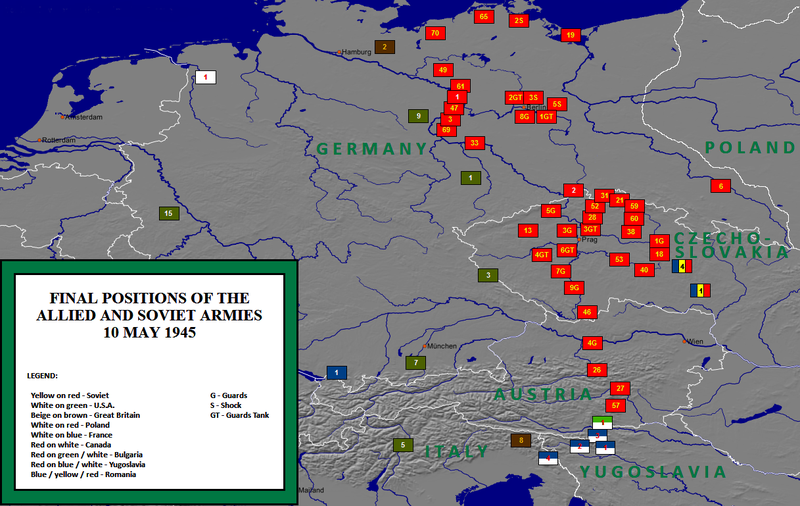Operation Unthinkable

The European front of World War II ended in May of 1945, but, of course, the fighting did not simply end in an instant. And more importantly, the victorious armies did not magically disappear from the battlefield. As seen above (much larger version here), on May 10, 1945, there were still troops throughout Germany. This was especially true for the Soviets, whose armies stretched from north of Berlin south, past Prague, and into northern Yugoslavia. For the Western Allies — primarily Great Britain in this case — the position of the Soviet armies and the history of the conflict to date posed a threat. The UK and the Soviets were allies of convenience, not ideology. In 1939, the Soviet Union and Germany entered into the Molotov-Ribbentrop Pact, in which the two sides agreed to divide Eastern Europe up amongst themselves (mapped out here); further, the Soviets subscribed to Communism while the Western governments eschewed it.
With Germany’s military neutralized, it was unclear what would happen next between the Soviet Union and the West — and this uncertainty was discussed months before the German surrender. Poland’s independence was specifically at risk, although subsequent ills may have befallen the rest of Europe if Poland were to fall once again. British Prime Minister Winston Churchill ordered that the British armed forces come up with a plan, codenamed Operation Unthinkable — a plan to strike the Soviet troops.
Churchill’s original intention was leverage the element of surprise in hopes of breaking the Soviets quickly, using the available British, American, and Polish troops in the region, as well as re-arming 100,000 German troops. Per the strategy document itself, declassified in 1998 (and reprinted here) the stated objective was “to impose upon Russia [a term used interchangeably if incorrectly, with the USSR] the will of the United States and the British Empire.” While that statement sounds rather imperial and, perhaps, was intended to be so, the document further clarifies: “Even though ‘the will’ of these two countries may be defined as no more than a square deal for Poland, that does not necessarily limit the military commitment. A quick success might induce the Russians to submit to our will at least for the time being; but it might not. That is for the Russians to decide. If they want total war, they are in a position to have it.”
“Total war,” advisors warned, wasn’t just a disfavored outcome, though — it was a likely one, and not a good one for the British Empire. At the time of the German surrender, Soviet troops in Europe outnumbered the Western Allies 4:1 and the Soviets had twice as many tanks. Furthermore, the American troops in Europe were being re-assigned to the Pacific for a potential invasion of Japan. Senior military leaders advised against turning against the Soviets, and Churchill reluctantly agreed.
Bonus fact: Go on a guided tour of London and you’ll see a statue of Winston Churchill in Parliament Square, and you may be told that there’s an slight electrical current flowing through it in order to keep pigeons off it. (Here are two sites mentioning this “fact.”) As the story goes, Churchill didn’t want his likeness to become a latrine for the birds, to the point that he preferred that he not have a statue at all. (A similar statue of Churchill in Toronto has exactly that problem.) This “fact,” though, isn’t true, despite the lack of guano suggesting otherwise. What keeps the birds (and bird poo) away? According to a 1973 issue of New Scientist, the electrical current idea was rejected and, instead, a pin-cushion of sorts was installed. The statue is mostly free of pigeon problems.
From the Archives: Invading Canada: The United States’ now defunct and declassified plan to take its neighbors to the north, just in case.
Related: A miniature statue of Winston Churchill, which for some reason has two reviews. (Both reviewers give it five stars.)
